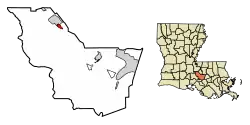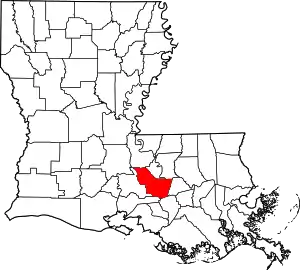Grosse Tête, Louisiana
Grosse Tête is a village in Iberville Parish, Louisiana, United States. The population was 647 at the 2010 census.[3] The village name is French for "Big Head",[4] while the local pronunciation is "gross tate".
Grosse Tête, Louisiana | |
|---|---|
Village | |
 Location of Grosse Tete in Iberville Parish, Louisiana | |
.svg.png.webp) Location of Louisiana in the United States | |
| Coordinates: 30°24′53″N 91°26′07″W | |
| Country | United States |
| State | Louisiana |
| Parish | Iberville |
| Government | |
| Area | |
| • Total | 1.49 sq mi (3.86 km2) |
| • Land | 1.47 sq mi (3.80 km2) |
| • Water | 0.02 sq mi (0.06 km2) |
| Elevation | 16 ft (5 m) |
| Population (2010) | |
| • Total | 647 |
| • Estimate (2019)[2] | 629 |
| • Density | 428.77/sq mi (165.51/km2) |
| Time zone | UTC-6 (CST) |
| • Summer (DST) | UTC-5 (CDT) |
| Area code(s) | 225 |
| FIPS code | 22-32020 |
| GNIS feature ID | 2407471 |
Grosse Tête is part of the Baton Rouge Metropolitan Statistical Area.
Louisiana State Senator Robert M. Marionneaux resides on a cattle farm in Grosse Tete but practices law in Baton Rouge.[5]
Geography
Grosse Tête is located in northern Iberville Parish at 30°24′53″N 91°26′7″W (30.414587, -91.435265).[6] It is bordered to the north by the village of Rosedale. Bayou Grosse Tete flows through the eastern side of the village.
Interstate 10 passes through the northern side of the village, with access from Exit 139. I-10 leads east 16 miles (26 km) to Baton Rouge and west 39 miles (63 km) to Lafayette.
According to the United States Census Bureau, the village has a total area of 1.19 square miles (3.07 km2), of which 1.17 square miles (3.03 km2) are land and 0.02 square miles (0.04 km2), or 1.41%, are water.[3]
Demographics
| Historical population | |||
|---|---|---|---|
| Census | Pop. | %± | |
| 1930 | 303 | — | |
| 1940 | 382 | 26.1% | |
| 1950 | 548 | 43.5% | |
| 1960 | 768 | 40.1% | |
| 1970 | 710 | −7.6% | |
| 1980 | 749 | 5.5% | |
| 1990 | 541 | −27.8% | |
| 2000 | 670 | 23.8% | |
| 2010 | 647 | −3.4% | |
| 2019 (est.) | 629 | [2] | −2.8% |
| U.S. Decennial Census[7] | |||
As of the census[8] of 2000, there were 670 people, 261 households, and 182 families residing in the village. The population density was 554.4 inhabitants per square mile (213.8/km2). There were 294 housing units at an average density of 243.3 per square mile (93.8/km2). The racial makeup of the village was 55.52% White, 42.84% African American, 0.30% Native American, 0.75% Asian, 0.30% from other races, and 0.30% from two or more races. Hispanic or Latino of any race were 0.45% of the population.
There were 261 households, out of which 31.0% had children under the age of 18 living with them, 46.7% were married couples living together, 19.2% had a female householder with no husband present, and 29.9% were non-families. 23.8% of all households were made up of individuals, and 9.2% had someone living alone who was 65 years of age or older. The average household size was 2.56 and the average family size was 3.06.
In the village, the population was spread out, with 27.3% under the age of 18, 7.2% from 18 to 24, 31.9% from 25 to 44, 19.7% from 45 to 64, and 13.9% who were 65 years of age or older. The median age was 36 years. For every 100 females there were 82.1 males. For every 100 females age 18 and over, there were 82.4 males.
The median income for a household in the village was $27,734, and the median income for a family was $32,188. Males had a median income of $25,417 versus $20,781 for females. The per capita income for the village was $12,840. About 16.7% of families and 23.4% of the population were below the poverty line, including 31.5% of those under age 18 and 27.6% of those age 65 or over.
Grosse Tete has become known for the Tiger Truck Stop where a live tiger was displayed for many years in an enclosure a near the parking lot, a display which brought notoriety to the business. The tiger, named Tony, passed away in 2017.
References
- "2019 U.S. Gazetteer Files". United States Census Bureau. Retrieved July 25, 2020.
- "Population and Housing Unit Estimates". United States Census Bureau. May 24, 2020. Retrieved May 27, 2020.
- "Geographic Identifiers: 2010 Census Summary File 1 (G001): Grosse Tete village, Louisiana". American Factfinder. U.S. Census Bureau. Archived from the original on February 13, 2020. Retrieved April 4, 2018.
- Hook, J. N. (10 June 2014). All Those Wonderful Names. Open Road Media. p. 252. ISBN 978-1-4976-1186-3.
- "Marionneaux LAW FIRM". marionneauxlawfirm.com. Retrieved 2018-07-25.
- "US Gazetteer files: 2010, 2000, and 1990". United States Census Bureau. 2011-02-12. Retrieved 2011-04-23.
- "Census of Population and Housing". Census.gov. Retrieved June 4, 2015.
- "U.S. Census website". United States Census Bureau. Retrieved 2008-01-31.

